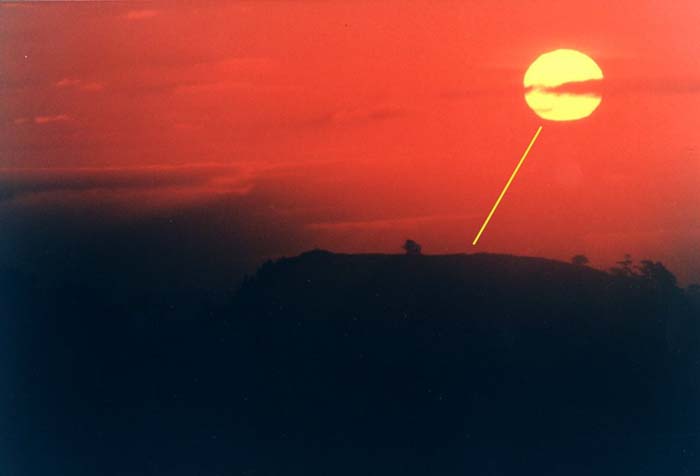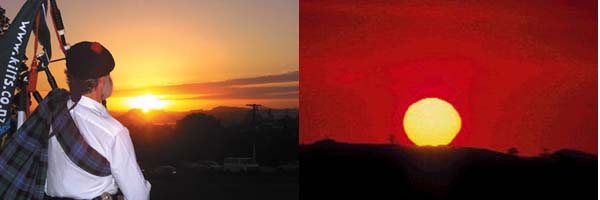EQUINOX EVENTS.
THE FIRST EQUINOX OF THE MILLENNIUM, SEEN AS A TIME TO REESTABLISH LINKS WITH THE DISTANT PAST.
Ancient civilisations were preoccupied with astronomy and keeping accurate calendar systems. By observations of the sun’s movements annually and recording its solstice and equinox positions, a careful count of days beyond these events, would determine when to plant, harvest, celebrate festivals or observe holy days (holidays). Solar movement, throughout the year, was the primary tool for determining the timing of significant events by civilisations worldwide.
An emerging science, here in New Zealand, is archaeo-astronomy and researchers, assessing ancient New Zealand sites, are beginning to find a strong astronomical component in the ruined stone structures or excavations scattered across the country.
Many marker stones or stone circle sites were set up in ancient New Zealand for accurately determining the solar equinoxes or solstices, as well as for more refined stellar fixes.
The 20th of March, 2000, marked the first equinox of the new calendar millennium and our Auckland (New Zealand) based archaeo-astronomical group, wanted to re-establish recognition, at the time of the equinox, of how a small section of the ancient astronomical alignment system of the Auckland Isthmus formerly worked.
This was a part of the system set up by the once numerous, stone-working people, some of whom Polynesian Maori called the Patu-pai-arehe, also referred to in Maori oral traditions as the “fairy folk”.
Using the 36 volcanic hills of the Auckland Isthmus, the pre-Polynesian Patu-pai-arehe devised and built a complex astronomical alignment system. One small part of this system related to an approximate east-west equinox line, which ran from ancient stone markers, found by 19th century surveyors, on Stockade Hill, Howick.
The line from Stockade Hill continued through the crest trench in the volcanic rim of Mt. Wellington, many kilometres directly west and then dissected an ancient standing stone marker on Mt Albert, yet further west. The Coromandel and Waitakere Ranges provided additional extensions to this approximate east-west dissection of the Isthmus, based upon sunrise and sunset.
Mt. Wellington, one of the 36 hills of the Auckland Isthmus modified by the ancient Patu-pai-arehe for astronomy. Note the “V” cut in the crest (right picture). This marks the setting position of the equinoctial sun, as observed from the centre summit of Stockade Hill, in the suburb of Howick. Early colonial surveyors noted the existence of pillars of stone and other, smaller stones in circular placement, atop Stockade Hill. These were later moved when a military stockade was built during the 1800’s.
The picture on the right looks westward through the Mt. Wellington “V”, over the hill’s volcanic cone, toward Mt. Albert, where the large, original equinox marker stone still resides, adjacent to the modern day trig. There are many significant alignments onto solar or stellar positions, coupled with overland mapping functions, originating from marked positions on these 36 Auckland hills. One hill uses another, more distant, hill or range as the target outer marker for a celestial event.
A group of enthusiasts, researchers and media representatives assembled on Stockade Hill, Howick, before sunset on the 20th of March 2000 to witness the equinoctial sun’s descent into the trench on Mt Wellington. The Sun’s journey down to its age-old equinox position was accompanied by the musical strains of a lone, Scottish piper, Bryan Mitchell. The ceremony, to re-establish recognition of the ancient astronomers of the Auckland Isthmus, was both moving and visually spectacular.


Bryan Mitchell, pipe player of Hamilton, New Zealand provides music to welcome back recognition and the reopening of an ancient stonebuilder equinox alignment. Howick historian, Andrew Adams, located an original surveying document, written by the British Army engineers who built the redoubt defenses on Stockade Hill in the 1800's, which recorded how standing stone markers had to be removed from the hill such that the defensive trenches could be dug. Mr. Adams gave the rare and valuable document, which had been located in an old library book, to the Howick Public Library personel and asked them to take special care of it. Subsequent attempts to acquire the document have not been successful, but Mr. Adams is prepared to issue an affidavit related to what the British engineers had written. It is largely because of his discovery of the engineer's report that the former, ancient significance of Stockade Hill was recognised and it's affiliation to Mt Wellington's crest trench, for equinoctial alignment observations, was rediscovered.
These New Zealand astronomical alignment systems are an exact counterpart to surviving marker systems from Great Britain’s Megalithic Age. A growing body of evidence establishes a link between civilizations of these two regions of the world and a part of that evidence relates to human skeletal remains, found with red hair, light brown or blond hues, observed since colonial times, in ancient burial caves throughout New Zealand.
New Zealanders and especially residents of Auckland, are encouraged to go to Stockade Hill to witness this recuring bi-annual event (Autumn & Vernal equinox sunsets). One needs to stand near the crown of the hill, towards the trenches on the northern side of the redoubt to see the descending equinoctial sun touch the Mt.Wellington trench. Please take a protective lens for eye safety when looking directly at the setting sun. This very ancient solar alignment is now reopened and can be enjoyed or celebrated twice annually for all the years ahead.
YOUR NEXT EQUINOX SUNSET, AS SEEN FROM STOCKADE HILL, IS TUESDAY SEPTEMBER 23rd AT ABOUT 6: 25 pm (THE TIME WHEN YOU'LL SEE IT HIT THE TRENCH ON MT. WELLINGTON).
The actual "official" moment of the worldwide equinox is at 11 pm NZST (11 hours UT) on the 23rd of September when the sun crosses the equator moving south.
These very ancient equinox and solstice maker systems will be found in all areas of New Zealand where there was a sizable community of the Stonebuilders. See if you can find the old cairn or standing stone markers in your region and figure out how those markers work with the distant horizon landscape. You'll be able to pretty much "double guess" where the markers should be, based upon where very distinct mountains, chasms, or prominent geological features sit on the distant landscape to the east or west of known archaeological sites in your district.
Wiccans, Pagans, Druids, Morris Dancers or anyone interested in ancient "seasonal celebration" history are encouraged to give these ancient equinox and solstice observation positions a new lease of life and bring them back into full public recognition. When you locate the old sites of your New Zealand region, please inform us here, as well as your local community groups and media.
LET THE ANCIENT NEW ZEALAND STONEBUILDERS
AND THEIR ACCOMPLISHMENTS BE REMEMBERED!